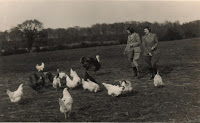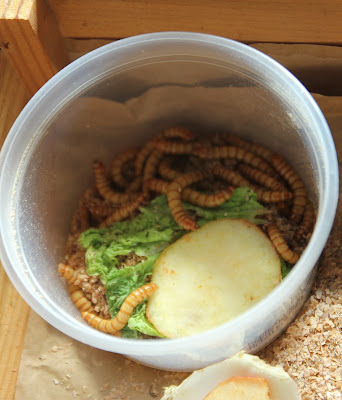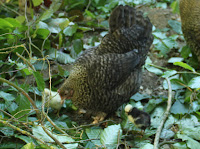I've always been concerned about the level of protein in the diet of my quail. This is not only from the point of view of egg laying but also and more importantly because from my observation that my quail undergo a complete personality change when they are short of amino acids such as L-methionine. They become fractious and argumentative with each other and shout angrily at me when they see me in the garden.
Can't wait for a mealworm!
There is also an established link between L-methionine deficiency and feather pecking, feathers being rich in protein, so if birds can't get it from their food they will consume feathers as an alternative source. L-methionine is absent in grain diets, therefore, if you see your poultry picking up and eating feathers from the ground then this is a good indicator that you need to up invertebrate or animal protein levels.
Behavioural problems with my quail usually happen when we go away because I can not expect my neighbours to be digging for worms or raiding the compost bins for woodlice. At a pinch I could leave them some frozen hard-boiled egg as this year, when we got ourselves really organised and made frozen dinners for all our poultry.
However when in July we came back off our trip to Scotland and my quail greeted me with disdain and all sneered at me as usual, I decided enough was enough and that I should try raising some organic mealworms for them. This was an idea I'd toyed with for some time and I rather launched myself into it rather than actually carry out my usual research methods. In the event I should have followed my instincts and found exactly how mealworms were raised commercially before I just purchased a tin of live bait from the 'hunting, fishing and shooting' aisle in my local big supermarket !
Let me also underline from the outset that information on-line concerning mealworms is contradictory, this includes everything from the life cycle of the invertebrate to its habits and foods. The following is what I garnered from reading but mainly from observation of what worked and what didn't. I also, as with previous articles I've written on poultry and symbiosis, including poultry and their relationship with parasites, began to question the perceived wisdom on the threat or otherwise posed by grain mites.
Problems With Sourcing Mealworms
I was heartened when, once out of the refrigerator, these mealworms not only began to speed up development but they also began to show signs of pupating. Conversely, when at a later date I bought another tub of fishing-bait mealworms from a different sporing goods shop and from another producer, these did not react in the same way. Once warm and fed, all but one of them, after an initial short period of growth, turned black and shriveled up. Thus only one of the worms remained to pupate. These mealworms were much larger than the previous ones and I had toyed with the idea of introducing them to the others to add a different 'bloodline' but obviously, I shelved that idea!
Detoxing Mealworms
After various conversations with organic farming friends, I decided that the antibiotic content of the mealworms should be capable of detox by feeding them an organic diet and by waiting for the second generation of worms. I was told that as the antibiotic feed was, by necessity, a constant in industrially raised mealworms that the residues would be minimal but I still decided to wait until my mealworms had changed to beetles and then produced a new generation of mealworms before I allowed my quail anywhere near them! I also kept them in a container of organic wheat bran before transferring them to their permanent home box, thus allowing them to have a full 24 hours in which to flush the first of the antibiotic residues. There is also the issue of pesticides to consider, as they had been kept in a substrate of non-organic bran!
Initial Conclusions On Mealworms - Home and Environment
As mentioned above and in line with what I had seen in multiple videos and in written articles, I had decided initially to try a conventional approach of raising them in plastic food-grade boxes but obviously on a substrate of organic bran. You can watch my first film (below) on this stage of the experiment to see firsthand how this worked out. In essence though these are the bullet points:
- A plastic box is not a good environment for the mealworms, it didn't allow for enough circulation of air and caused issues with the beetles' development.
- There was obviously a problem with the bran substrate as the poor development of the beetles' wing cases was eventually diagnosed as an uneven moisture problem in the plastic box. Either too much water causes mold or too little causes the emerging beetle to dry out too quickly.
- Like many invertebrates, the life cycle of these creatures is complex.
- From an initial few beetles which developed from my fishing-bait mealworms, I had very few mealworms hatch out.
Thanks for dropping by and do feel free to share experiences or ask for further information in the comment section. If you have enjoyed this piece and found it useful think about sharing it with your family and friends, on social media and also maybe about joining this blog and/or subscribing to my Youtube, Odysee or BitChute Channel or even supporting us on Patreon or
Until next time, all the very best from sunny Normandie!
© 2023 Sue Cross
It all helps to keep me going!
Until next time, all the very best from sunny Normandie!
Sue
RELATED ARTICLES
Raising Mealworms Organically for Optimum Poultry Protein -- Part Two
As with all my work both writing and films, my intention is to share that observation is key in the understanding of how we can best raise our poultry. This also holds good for how we raise...read more

Food for Free. Fabulous Forage Part 1 Grass
For centuries farmers and homesteaders raised poultry on a forage-based diet supplemented only by a handful of grain and the occasional..read more
Food for Free. Fabulous Forage Part 2 Chickweed
Stellaria media an incredible food and medicinal for poultry, an in-depth look at this ubiquitous weed..read more
Food for Free. Fabulous Forage Part 3 Tree Fodder & Tree Hay
The idea of tree fodder is inextricably linked with the changing landscape, the full domestication of animals, the concept of farming and the clearance of the forests... read more
Food for Free. Fabulous Forage Part 4 Roses for Food & Forest
For me the rose is the quintessential forest garden plant, from canopy to ground cover there are so many to choose from ... read moreFood for Free. Fabulous Forage Part 5 Rose Petals
One of the main roses I use for both cooking, medicinals and which my hens very much enjoy is, not surprisingly, rosa gallica Officinalis, or The Apothecary Rose... read more
Food for Free Fabulous Forage Part 6 Rose Leaves and Hips
For thousands of years the rose, hips, leaves and blossoms have been used as medicinals for both physical and nervous system ailments. .....read more
Part 6 dealt in detail with the nutrient value and here we look in depth at why these are crucial for optimal physical and nervous system health...read more
Food For Free Fabulous Forage Part 8 Air Meadows for Poultry & Livestock
'Air meadows' is the beautiful description for a multi millennial old tradition of feeding European livestock. The standard way of growing trees for...read more
Food For Free Fabulous Forage Part 9 Tree Choices Poultry & Livestock
Depending on your climate and native (or well-established) species of trees there are so many options to choose from when planning to grow these valuable forage crops...read more














No comments:
Post a Comment